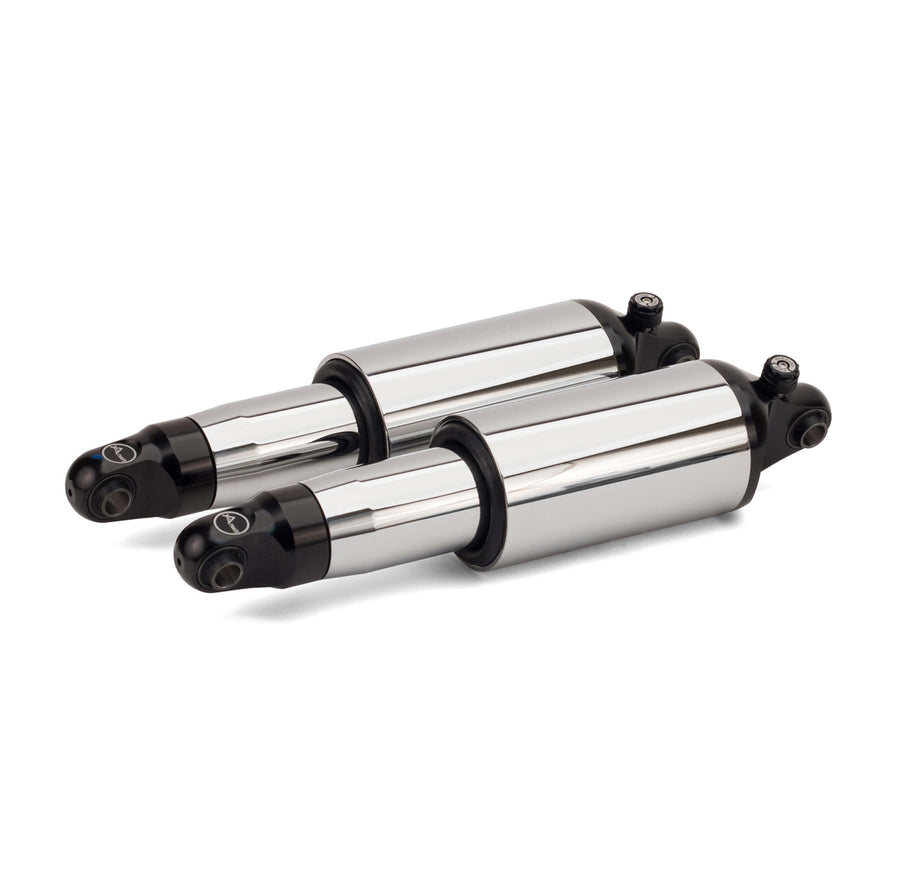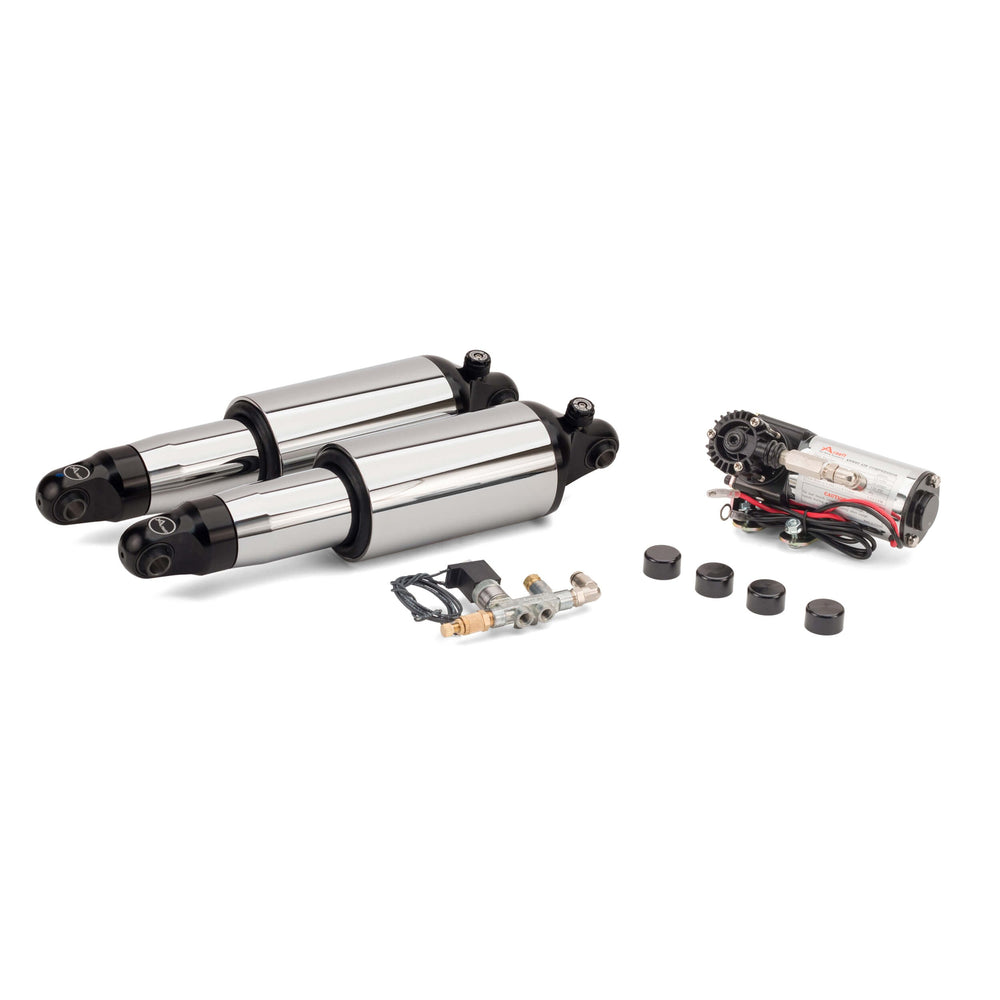Guide to Riding V-Twins for the Inseam Impaired
Do you long to hit the road on a big V-Twin Harley-Davidson®, but think the bike may be a bit big for you? At over 800 pounds, large tourers and cruisers can be intimidating for anyone, much less somebody who is smaller in stature or mobility impaired. But does that mean you need to forget about your dream bike? In a word – no.
Motorcycles are designed for an average rider weighing in at about 179 pounds and standing just under six feet tall. Statistically, for this rider to be considered the average, we know there must be many people who are both larger and smaller who enjoy riding. Plus, as riders age they shrink – Men can lose an inch between age 30 and 70 and women can lose two inches. Despite this mathematical reality, manufacturers often miss the mark when it comes to the fine balance between affordability and inclusivity; providing ride quality and proper seat height for the broad size range of riders has historically proven to be a challenge in motorcycle design.
Whether you’re an older, smaller, or mobility-impaired rider doesn’t mean you can’t enjoy the thrill of riding big V-Twin touring bikes or cruisers with confidence - especially while stopped or parking. While there are multiple ways you can lower your seat such as lowering links, shorter shocks, shaved seats and thicker boots souls, most include both advantages and challenges regarding safety, handling, comfort and ride quality. Choosing the right bike, utilizing the appropriate clothing and bike accessories, and upgrading to air suspension can all bring your ride experience to the next level.
Smaller displacement bikes are fun
While your goal may be riding to Daytona with your passenger on a new Road Glide, if you are new to riding and have some extra time and money, you may wish to get used to various road and parking conditions by practicing on a smaller bike. There are many smaller, lighter, bikes that will enable you to gain enough riding experience and confidence so that you will feel more comfortable once you start riding larger bikes.
Buy the right big bike
You don’t have to stick with that smaller bike forever. Once you are comfortable and confident in your riding abilities you can start looking for the bike of your dreams – especially if it has a nice low seat.
Low and Thin: If it is a big V-Twin bike you lust after, pick one that has a seat that fits you. It’s not just about having a low seat, you’ll want one that is narrow too. Thinner seats enable you to get your legs closer together which means you can reach to the ground easier.
Light: Consider a lighter bike too. If you are on your tiptoes when just sitting on the bike, it is easier to hold a light bike up than a heavy one.
Here are a couple of popular options:
- The Harley-Davidson’s Sportster 883 SuperLow weighs in at just 489 lbs. and has a seat height of just 25.5 inches
- At 533 lbs. the Indian® Scout has a low (25.3”) and a narrow seat
- Harley-Davidson Sportster 1200 Custom weights 591 lbs. with a seat that is 26.6 inches off the ground
- The 663 lbs. Honda® Fury’s seat is the same height as the rear tire sitting just 26.5 in from the ground.
- Harley-Davidson Softail Deluxe seat is a scant 24.5 inches and weighs 697 lbs.
- The H-D Fat Boy Lo is 733 lbs. with a seat height of 26.5 inches
- In case you are wondering – The Harley-Davidson Street Glide has a seat height of 26.1 inches and weighs 810 lbs.
Check your suspension sag
Before you make any modifications, check your bike’s suspension sag, especially if you are close to resting comfortably on both feet. Suspension sag, or the amount the bike should lower under your weight, can be adjusted by adding or removing spring preload on your shock, improving your overall ride.
Motorcycle suspension is designed to be ridden with about 25-30% of the overall travel used when the rider, passenger and luggage are on the bike. Setting proper sag will always allow your motorcycle’s remaining suspension travel to absorb the rebound (upward movement) of the wheel and compression (amount the shock compresses to enable the wheel to drop down into dips) to safely keep your tire in contact with the road.
Most manufactures provide a sag specification for their bike’s rear suspension. This may be listed as a measurement (ex. 50mm), as a percentage (ex. 30%), or as a ratio (ex. 135:65). If you do not have access to this, you can simply take the total rear suspension travel of your motorcycle and use 25-30% of that as your sag specification.
Thick shoe soles
A high-quality pair of motorcycle boots is an indispensable accessory for riders and their safety. Proper boots not only protect against the elements, but also help to prevent injury to ankles and feet. The best boot soles are oil-resistant and made from thick Vibram, which will prevent marring of floors and won’t melt if touching hot pipes. A textured or grooved sole is also helpful to avoid slipping while stopped, maneuvering your bike while parking, or dismounting.
Some smaller riders buy boots with extra thick or platform soles to give them a bit more reach or they add lifted insoles which can provide an extra 1-2 inches in the heel. The best motorcycle boots for short riders provide extra height to the entire foot to make riding more comfortable.
Boots with a thicker sole are a reasonable long-term solution, but you must make sure they are proper motorcycle shoes which still provide easy access and a good “feel” for the brake and clutch levers. Boots that are very thick may require you to adjust the shifter peg because the stock configuration on some bikes doesn’t leave enough room. Thicker soles can also be stiff and may not be comfortable for walking longer distances (over ¼ mile). High heels or raised heels are not suitable because they provide no additional reach for the toes, just the heels.
Top brands with thicker soles include Whites Smoke Jumper and Sidi Adventure.
Shaved and Thinner Seats
A popular option for smaller riders is to buy a lowered seat if available. Manufacturers do offer some seats designed for short riders, but most will find a wider selection offered by aftermarket suppliers.
You can also have your current seat customized by motorcycle upholsterers who will cut out some of the foam and replace it with thinner memory foam or a gel insert to try and maintain some comfort. Just about all seats can be altered.
When you are looking for a lower seat height also make sure you consider the width of that seat. As mentioned earlier, a narrower seat means that there is less distance between your thighs which makes it easier for your legs to touch the ground. Look for a seat with a narrow front. A narrower front also allows you to move forward so you can better reach not only the ground - but also your foot controls.
Lowering Links
Lowering the rear end of a bike also lowers the seat, making it easier to flat-foot at stops. One popular modification for a lowered rear end is adding lowering links (also called blocks, lowering blocks, bones, and dog bones). These are spacers that relocate the rear shock's bottom mounting bushing one to three inches to the rear which lowers the seat a half to two inches depending on the bike. They're inexpensive, easy to install and they do lower the back of the bike.
Keep in mind that the linkage system is an important part of the bike’s rear suspension. A stock linkage system is designed to work with a specific spring rate and shock damping and is designed to provide adequate ground clearance and lean angle. When you add longer lowering links, it changes the angle of the shock and the shock’s leverage ratio. Riders may find that the rear shock bottoms out sooner with links. You’ll also need to pay attention to the new clearance between your suspension parts and the exhaust, engine, and fenders. Since the fender is now closer to the wheel it can cause the rear tire to rub against the fender on big hits, which can cause damage or even lead to a crash. Check with the lowering link manufacturer to ensure their lowering links offer enough rear fender clearance for your model.
Changing the suspension in this way to lower a bike also changes the bike’s handling since it reduces the amount of available lean angle and lowers ground clearance for obstacles such as speed bumps. If lowered too much or done improperly links could make the bike’s handling erratic and even dangerous. Dragging pegs can happen to anyone while riding sharp turns or maneuvering twisties but it's no fun when those pegs hit a pot hole or bump in the asphalt. Most people know riders who have gone down from dragging pegs.
A permanently lower suspension also means your bike will stand up straighter on your stock kickstand which could mean your motorcycle will be a lot easier to tip over when parked.
As mentioned earlier the use of lowering blocks changes the angle of the shock. Be careful since this can cause shock failure since the weight of the bike will rest and bounce differently on the shock at this new angle. Also remember, the use of lowering blocks voids most aftermarket shock warranties.
Lower Shocks & Air Suspension
Shorter slammed shocks
Another popular way to lower your suspension without using lowering links is to replace the stock 12” or 13” shocks with shorter shocks. These shocks range in size but popular aftermarket options are 11” dropping your Touring bike by 1-2”. They use shorter dampers and steel springs that offer a spring rate designed for the shorter shock. Before getting shorter shocks from an aftermarket manufacturer, make sure the product is well designed and made. Keep in mind, however, there are significant tradeoffs to a smaller shock length.
If you lower the motorcycle 1", you will lose 1" of shock travel. A motorcycle with 3" of travel that is lowered 1" will lose 30% of the ability to absorb bumps. Remember, you have already reduced that travel because of sag so the additional reduced travel will increase the changes of painful bottoming and decrease ride quality. Lowered shocks will generally have stiffer spring rates and damping to compensate for the reduced travel. The bike's lean angle will be reduced too. If you drag pegs occasionally at the stock ride height, you will do so more frequently if the bike is lowered. Also, be prepared to give up some load capacity since a lowered bike can’t have the same load capacity do to suspension travel.
Popular shortened shock options include Fox, Burley Slammers, Progressive, Harley LowRider
Adjustable Air Suspension
For riders who want a lowered suspension to lower their seat temporarily but who don’t want the issues associated with permanent lowering options such as loss of ground clearance, reduced lean angle, and painful bottoming there are adjustable air shocks. These kits, which were first released about ten years ago, include dampers but replace the steel coil springs with rubber air bladders which are inflated with an on-board compressor and switch, so they can be instantly aired out or lowered for stopping or parking and quickly inflated again once the biker is ready to ride.
Adjustable air suspension kits can instantly lower a bike by 3 to as much as 5 inches. Remember, lowering them anymore than the bike’s stock travel could lead to the tire rubbing on the fender, shocks hitting the exhaust, and other safety concerns. Some vendors, such as Arnott, custom design their air ride shocks to use the same travel as the OE so dumping the air out won’t allow the fender to rub and once inflated again will handle like the OE. Some air shock designs may handle better than stock since the compressive and expansive nature of rubber springs vs steel springs keep the tire firmly on the road while absorbing bumps.
While many of today’s touring and cruiser models include “air assisted” shocks, these are much different than true adjustable air shocks. For one, the stock air assisted shocks are just a twin tube damper with a coil spring inside a cylinder of oil which can be raised and lowered about a half inch using a hand air pump. There is little pre-load or adjustability to lower the suspension and the seals may leak if inflated to over 50 psi. Many riders report shock fade, bottoming out and a harsh ride after just a few thousand miles on the stock air assisted shocks.
Another widely used option are kits made from older Corvette automobile shocks. While they may fit if modified correctly - they were made for a 30-year-old, 3,700 lbs., automobile with leaf springs. The air bladder volume is much smaller, so it can’t absorb the bumps as well and the older twin tube damper design is subject to fade and doesn’t provide the plush ride of a modern monotube shock. They also were manufactured without bump stops so bottoming over bumps could cause metal on metal fatigue and shock damage to the top and bottom mounts. Some vendors may have welded these just to work on a motorcycle. While these shocks can be purchased online for as little as $65 the additional air ride components are also typically cast-off, cheaper, parts such as plastic T valves, weak compressors and mounting brackets and poor inflation switches and electronics.
True adjustable air suspension kits offer much more than just the ability to temporarily lower a motorcycle – they also greatly improve ride quality. Many luxury cars today such as the Mercedes-Benz S-Class and Audi A8 include air suspension because it offers a luxury ride that simply can’t be matched by steel coil springs. As with air struts found on high-end cars and SUVs, motorcycle air shocks also provide a much improved, and more luxurious, ride. Quality kits typically include a name brand damper that is custom valved for the weight and ride characteristics of individual makes, models and years of a given bike. The added air spring takes advantage of the compressive abilities of air and rubber to absorb vibrations and bumps providing a superior ride over smooth highways, winding back roads or jarring pothole laced streets.
Popular true adjustable air suspension system vendors include Arnott Air Suspension
Other Tips:
- Shorter riders need to understand that your heels may never touch the ground fully while on your bike. Being able to control your motorcycle without being flat-footed will get easier as you gain the confidence that experience can provide.
- When parking it may be easier to get off your bike and push it into a parking space.
- When slowing down, use your brakes, clutch and lower gears to gradually slow down and perhaps avoid stopping completely. Look ahead and plan your stopping distance to give yourself plenty of time. There are even contests at some motorcycle events called ‘Slow Races’ where the last man standing wins.
- Watch out for anything that can cause your foot (toes) to slip such as slick painted lines, loose gravel, wet leaves or any debris.
- Remember that it is not against the law to stop next to a curb, so you can put your foot on it for support.
Conclusion
Being smaller, older or mobility-impaired leads to many challenges in life - riding a big V-Twin motorcycle doesn’t have to be one of them. Between learning to better handle all bikes, boots with thicker soles, shaved seats and the temporary lowering offered by air suspension - riders have multiple, effective, options at their disposal for the safe handling of just about any motorcycle.




Leave a comment